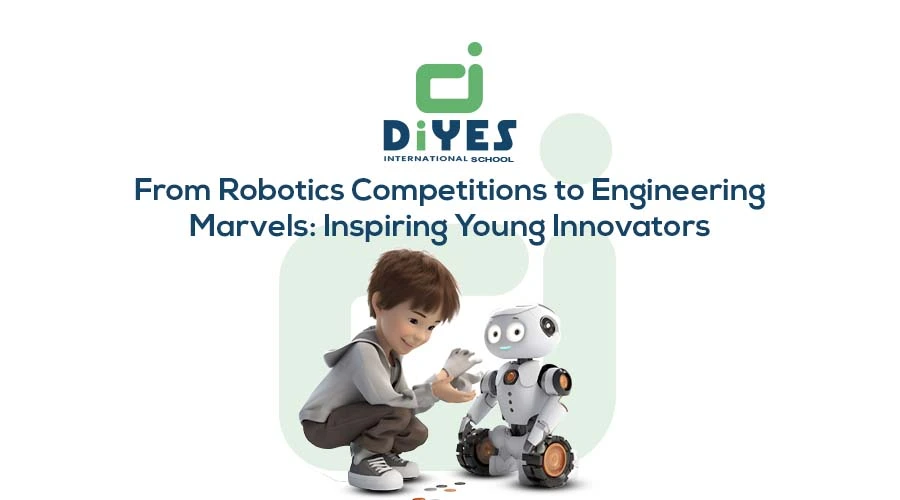In an age defined by technological advancements and groundbreaking innovations, nurturing the next generation of engineers and inventors is more crucial than ever. Robotics competitions for kids serve as catalysts for this transformation, providing young minds with a platform to unlock their creativity, problem-solving skills, and entrepreneurial spirit. From designing and building robots to competing in high-stakes tournaments, these competitions offer students a hands-on experience that goes beyond traditional classroom learning, igniting their passion for STEM (Science, Technology, Engineering, and Mathematics) fields and inspiring them to pursue careers in engineering and technology. These experiences are particularly impactful when starting at an early age, as seen in robotics competition elementary school programs.

This blog explores the journey of young innovators from participating in robotics competitions for kids to creating engineering marvels. From the excitement of building and programming robots to the satisfaction of solving real-world problems, discover how these competitions ignite passion, creativity, and ingenuity in the next generation of engineers and inventors. Through anecdotes, insights, and success stories, explore the transformative impact of robotics competitions in shaping young minds and inspiring innovation. The foundation often starts with robotics competition elementary school initiatives, setting the stage for lifelong interest and achievement in engineering and technology.
The Thrill of Robotics Competitions
Robotics competitions captivate the imagination of young innovators, offering them an immersive experience that combines technical skill with strategic thinking and teamwork. From local tournaments to international championships, these competitions provide students with an opportunity to showcase their talents, test their abilities, and push the boundaries of what is possible in robotics.
- Building and Programming Robots: Participants in robotics competitions are tasked with designing, building, and programming robots to complete specific tasks or challenges. From navigating obstacle courses to completing complex missions, students learn to apply principles of engineering, physics, and mathematics to bring their creations to life, honing their technical skills and problem-solving abilities in the process.
- Collaboration and Teamwork: Robotics competitions nurture collaboration and teamwork among participants, as teams work together to design, build, and optimize their robots for competition. Whether it’s brainstorming ideas, dividing tasks, or troubleshooting issues, students learn to communicate effectively, compromise, and work towards a common goal, developing essential interpersonal skills that are invaluable in any field.
- Strategy and Innovation: In robotics competitions, strategy and innovation are key components of success. Teams must devise unique approaches to overcome challenges and outmanoeuver their opponents. From refining robot designs to implementing novel programming techniques, students learn to think critically, think outside the box, and push the boundaries of innovation. This spirit of creativity and ingenuity not only enhances the competition experience but also lays the groundwork for future breakthroughs in engineering and technology.
- The Excitement of Competition: Robotics competitions are more than just academic exercises; they are exhilarating events that bring together teams from around the world to showcase their skills and talents. The atmosphere is electric as students compete in head-to-head matches, with spectators cheering on their favourite teams and robots. The thrill of competition fuels students’ passion for STEM fields and inspires them to push themselves to new heights of excellence.
- Learning from Failure: In robotics competitions, failure is not only accepted but taken as an essential part of the learning process. When robots malfunction or strategies fall short, students have the opportunity to analyze their mistakes, iterate on their designs, and improve their performance. This resilience and perseverance in the face of failure are invaluable qualities that students carry with them into their future endeavors, whether in academia, industry, or entrepreneurship.
Inspiring Future Innovators
Robotics competitions have a profound impact on participants, inspiring them to pursue careers in engineering, technology, and related fields. Beyond the thrill of competition, these events cultivate a lifelong passion for innovation, problem-solving, and making a positive impact on the world. Through exposure to cutting-edge technology, mentorship from industry professionals, and opportunities to collaborate with peers, students gain the skills, confidence, and motivation to pursue their dreams of becoming inventors, entrepreneurs, and leaders in STEM.
- Sparking Interest in STEM: Robotics competitions play a crucial role in sparking interest in STEM fields among young people, particularly those who may not have considered careers in engineering or technology.

By engaging students in hands-on, experiential learning experiences, these competitions make STEM subjects accessible, relevant, and exciting, inspiring students to explore new interests and pursue educational and career pathways in STEM-related fields.
- Mentorship and Role Models: Mentors and role models play a significant role in shaping students’ experiences and aspirations in robotics competitions. Whether it’s teachers, coaches, industry professionals, or alumni, mentors provide guidance, support, and inspiration to students, helping them navigate challenges, develop new skills, and realize their full potential. By sharing their knowledge, expertise, and passion for STEM, mentors empower students to pursue their goals with confidence and determination.
- Real-World Applications: Robotics competitions provide students with opportunities to apply their skills and knowledge to real-world problems and challenges. Whether it’s designing robots to assist with disaster response, improve healthcare outcomes, or address environmental issues, students gain a deeper understanding of the practical applications of STEM and the potential impact of their work on society. This hands-on, project-based approach to learning nurtures creativity, innovation, and a sense of purpose among participants, motivating them to use their talents to make a difference in the world.
- Empowering Diversity and Inclusion: Robotics competitions are inclusive and welcoming environments that celebrate diversity and promote equity in STEM fields. By providing opportunities for students from diverse backgrounds and experiences to participate and succeed, these competitions break down barriers, challenge stereotypes, and create pathways for underrepresented groups to pursue careers in engineering and technology. By nurturing a culture of inclusivity and belonging, robotics competitions empower all students to explore their potential and contribute to the future of innovation and discovery.
Cultivating Problem-Solving Skills
Robotics competitions serve as fertile grounds for cultivating problem-solving skills among participants. From identifying challenges to devising innovative solutions, students are confronted with a myriad of problems that require critical thinking, creativity, and perseverance to overcome. Through hands-on experimentation and iterative design processes, students learn to approach problems methodically, analyze data, and implement effective solutions, honing their problem-solving skills in the process.
- Identifying Challenges: In robotics competitions, students are presented with a variety of challenges that require them to think critically and creatively. Whether it’s navigating an obstacle course, manipulating objects, or completing complex tasks, students must first identify the underlying problems and understand the constraints and requirements of the competition.
- Designing Solutions: Once the challenges are identified, students must design and develop solutions that address them effectively. This process involves brainstorming ideas, prototyping designs, and testing prototypes to evaluate their functionality and feasibility. By iterating on their designs and incorporating feedback from peers and mentors, students refine their solutions and optimize their performance in the competition.
- Implementing Strategies: In addition to designing solutions, students must also develop strategies for implementing them successfully. This may involve programming robots to execute specific tasks, coordinating actions with teammates, or devising game plans for achieving strategic objectives.

By thinking strategically and anticipating potential obstacles, students increase their chances of success in the competition and develop valuable skills for problem-solving in real-world contexts.
- Reflecting on Results: After the competition, students have the opportunity to reflect on their performance, analyze their results, and identify lessons learned. This reflective process allows students to gain insights into their strengths and weaknesses, celebrate their successes, and identify areas for improvement. By incorporating a growth mindset and seeking continuous feedback, students develop resilience and adaptability, essential qualities for success in any field.
Robotics competitions serve as fertile grounds for cultivating essential problem-solving skills among participants. Through hands-on experimentation, iterative design processes, and strategic thinking, students develop the ability to tackle challenges with confidence and creativity. By accepting failure as a stepping stone to success and reflecting on their experiences, students emerge from robotics competitions equipped with the resilience, adaptability, and critical thinking skills needed to excel in academic and professional settings alike.
Nurturing Innovation and Entrepreneurship
Robotics competitions inspire a culture of innovation and entrepreneurship among participants, encouraging them to think creatively, take risks, and pursue ambitious projects that push the boundaries of what is possible. From developing groundbreaking technologies to launching startups and social enterprises, students are empowered to turn their ideas into reality and make a meaningful impact on the world around them.
- Encouraging Creative Thinking: In robotics competitions, students are encouraged to think creatively and explore unconventional solutions to complex problems. Whether it’s designing novel mechanisms, integrating cutting-edge technologies, or applying principles from different disciplines, students are empowered to push the boundaries of innovation and challenge the status quo.
- Nurturing Collaboration and Networking: Robotics competitions provide students with opportunities to collaborate with peers, mentors, and industry professionals, nurturing a culture of collaboration and networking. By working together on projects, sharing ideas, and exchanging feedback, students build valuable relationships and expand their professional networks, laying the foundation for future collaborations and partnerships.
- Providing Platforms for Showcasing Innovations: Robotics competitions offer students a platform to showcase their innovations and inventions to a broader audience. Whether it’s through presentations, demonstrations, or exhibitions, students have the opportunity to share their projects with judges, sponsors, and the public, gaining recognition and validation for their work. This exposure not only boosts students’ confidence but also opens doors to opportunities for further development and commercialization of their ideas.
- Cultivating an Entrepreneurial Mindset: Robotics competitions cultivate an entrepreneurial mindset among participants, encouraging them to identify opportunities, take calculated risks, and pursue their ventures with passion and perseverance. Whether it’s launching a startup, developing a product, or implementing a social innovation, students learn to think like entrepreneurs, welcoming uncertainty and accepting failure as essential steps on the path to success.
In summary, robotics competitions inspire a culture of innovation and entrepreneurship among participants, empowering them to think creatively, take risks, and pursue ambitious projects. By providing a platform for students to showcase their inventions and ideas, these competitions encourage them to explore new horizons and envision solutions to real-world problems. Through collaboration, networking, and exposure to real-world applications, students develop the skills, confidence, and mindset needed to become the innovators and entrepreneurs of tomorrow.
Conclusion
Robotics competitions stand as transformative platforms that nurture problem-solving skills, nurture innovation, and inspire the next generation of engineers and innovators. Through these competitions, young minds are challenged to think critically, work collaboratively, and push the boundaries of what is possible in the realm of technology and engineering. The thrill of competition, coupled with the opportunity to tackle real-world challenges, ignites a passion for STEM fields and empowers students to pursue careers that align with their interests and aspirations.
Furthermore, robotics competitions instill invaluable life skills in participants, including resilience, perseverance, and adaptability. As students encounter setbacks, iterate on designs, and learn from failures, they develop the resilience needed to navigate challenges and overcome obstacles in both academic and professional settings. This resilience, coupled with the ability to iterate and innovate, prepares students to excel in an ever-evolving world where creativity and adaptability are paramount.
Additionally, robotics competitions cultivate a culture of innovation and entrepreneurship among participants, empowering them to explore new ideas, take risks, and pursue ambitious projects. By providing students with a platform to showcase their innovations and inventions, these competitions encourage them to think like entrepreneurs and envision solutions to pressing global challenges. Through collaboration, networking, and exposure to real-world applications, students gain the skills and confidence needed to transform their ideas into reality and make a positive impact on society.
At DiYES International School, we recognize the transformative power of robotics competitions in shaping the future leaders and innovators of tomorrow. Through our comprehensive STEM education program and state-of-the-art facilities, we provide students with the resources, support, and opportunities they need to excel in robotics competitions and beyond. From hands-on projects to mentorship programs, we nurture a culture of curiosity, creativity, and collaboration that empowers students to unlock their full potential and become leaders in STEM fields.
To learn more about DiYES International School and our commitment to excellence in STEM education, visit our website at www.diyesinternational.edu.in or contact us at +918547609000.


